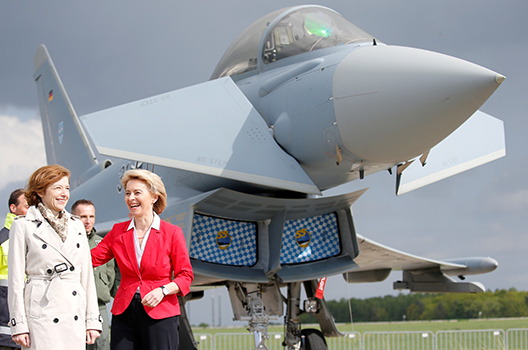Germany’s defense budget is on the march upwards, but can Berlin maintain the spending momentum given the prospects of a slowing global economy? There are also questions about how the country should spend its defense euros in the long term, say defense officials and policy experts.
Germany has long been an underspender when it comes to meeting NATO’s defense budget guideline of 2 percent of GDP for each of its allies, but that is now changing.
Since the allies’ collective pledge at their 2014 Wales Summit to march toward 2 percent by 2024 Berlin has repeatedly acknowledged that it won’t make 2 percent by 2024. But it has committed to reaching 1.5 percent of GDP for defense by then.
So far, the Wales pledge has been working. NATO estimates that the European allies plus Canada have spent $41 billion more on defense since 2016, and will have spent $100 billion more by the end of 2020 compared to the same year. By 2024 they will have spent $350 billion more, the Alliance says.
As for Germany, Berlin has steadily raised defense spending from 1.18 percent of GDP in 2014 to 1.24 percent in 2018. Moreover, its draft defense budget for 2019 proposes €41.54 billion, a €3 billion year-on-year increase.
Whether this orderly stair-step progress to 1.5 percent will be smooth sailing is another matter. Germany’s economy is slowing and, along with it, its tax revenues.
Recent press reports cite finance ministry documents that point to an overall government budget shortfall of nearly €25 billion from now through 2023, with possible implications for Germany’s carefully planned defense spending increases. The final numbers and their implications won’t emerge until the end of March.
Despite the risk of lower increases to its defense budget, Germany still aims to make that 1.5 percent target, according to one German defense policy official.
“We are still working on our 2020 budget and our perspective to 2023, and what this means in concrete terms is still under discussion,” the official, who spoke on condition of anonymity, said on February 12. “But we have reaffirmed [to NATO] our intention to spend 1.5 [percent] by 2024.”
So could Germany’s defense budget be ring-fenced from the impact of a wider government budget shortfall? “I can’t say, but if we want to reach our 1.5 percent goal, then we will need steady increases in defense spending,” is all the official would say.
Other allies observe that it is important that Germany stay the budgetary course not only because its economy, the largest in Europe, will account for the largest component of future increases in the European allies’ spending, but especially to modernize the country’s forces.
“From our perspective, it is crucial that Germany take its burden-sharing seriously because it is a major ally,” a British diplomatic source said on February 11. “This is not about creating a huge army, it’s more about improving the quality of Germany’s army and getting its forces’ readiness in order, which is very expensive to maintain.”
Despite the looming potential pressure on Germany’s overall budget, Berlin (and other underspending European capitals, for that matter) could get some breathing room regarding their performance against the 2 percent NATO spending target.
For NATO, that target comprises “cash, capabilities, and contributions”: money in a country’s defense budget, its outlay on development capabilities and, finally, the cost of its troop and materiel contributions to allied operations.
How to define those three streams—what things to include in them as costs—is still being worked out among the allies. NATO defense ministers were to review, again, the concept during their February 13-14 meeting in Brussels.
As one NATO ally put it on February 12, “we have to make sure everyone counts what they should and in the same way.”
For example, there is growing support to include an ally’s spending on infrastructure for so-called military mobility to enable NATO troops to transit rapidly across Europe—no matter the source of the money. Thus, if a country’s transport ministry spent its budget to improve a bridge or runway that also happens to facilitate the movement of military equipment and personnel, then that money could count toward the country’s 2 percent spending.
Notably, Italian Defense Minister Elisabetta Trenta, a member of the country’s populist Five Star Movement government, has called on NATO to go even further and include social spending in the calculation. There is little chance that would ever fly, though.
More interestingly, the “3C” debate (“cash, caps, and contributions”) points straight to the European Union’s gigantic so-called Structural Funds for infrastructure spending across the European continent. Worth hundreds of billions of euros, the EU and NATO have already cross-identified where and how the funds could be spent to generate the most dual-use benefit for both the EU’s economy and the allies’ military mobility needs.
Such spending would constitute only a small slice of the overall Structural Funds. However, even a small slice of hundreds of billions of dollars would be nothing to spit at, and at the same time would help narrow the official defense spending gap of more than a few allies—at least on paper.
Brooks Tigner reports on EU and NATO foreign, defense, and security policy from Brussels, where he has separated reality from rhetoric for the past twenty-five years.
Image: German Defense Minister Ursula von der Leyen and French Minister of the Armed Forces Florence Parly stand next to Eurofighter as they visit the ILA Air Show in Berlin, Germany, April 26, 2018. (REUTERS/Axel Schmidt/File Photo)

